| |||
NOTE: This lesson has LOTS OF GRAPHICS. So wait a bit till all graphics are loaded ^_-
Hi !. An indispensable part of a CRPG are, without
any doubt, combats. After all, Why we play CRPGs?. Yes, for the history,
but there's something more... Yes! for saving the world while we kick big
boss's ass! (or fleeing returning later with lots of weapons).
In this lesson we won't see any implementation,
but we will speak about some combat types (according to our approach) that
have existed for the (Japanese) CRPGs.
And a warning. We are not expert in history of the
CRPGs, so there'll be some failures. Anyway, we have tried to document
ourselves with the best sources.
Turn-Based Combats
Strategical Combats
Adventure RPG's Combat
Strange Combat Systems
And How can I program this?. Basics
Final Words
AND the light was made...
... and CRPGs appeared. In the start of everything, the combats were "I collide with you and i make damage to you", but then Richard Garriot and Japaneses appeared, and they changed the basis. We'll speak about Lord British (Richard) later, but this it is a section dedicated to the red and white color (Japanese).
About the first turn-based Japanese CRPGs games,
We would not dare to give a date and a specific title. Although we can
specify two games like the beginning of the actual CRPGs madness ^_^: Dragon
Quest, of Enix, and Final Fantasy
, of Squaresoft
(and later Phantasy Star of Master System).
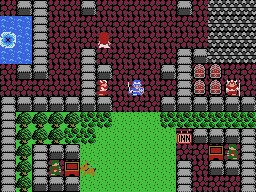 |
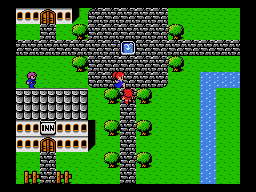 |
|
|
|
Both based their combat system on turns. In that combat style, the characters chose the action that they want to take (attack, magic, use an item or escape). The enemies made the same thing, and when all chose their actions, the computer solved the combats, according to a rigorous order of turns (first Rami, next Cockatrice, and at last Rui).
Now will comment the main characteristics of this combat system, and then we will expose the variants that exists (they are based mainly in how the combat is shown).
Characteristics of this system
The main characteristics of this combat system are exposed now. It would be necessary to comment that some characteristics can be "break", with the purposes of making a more interesting combat (p. e.g. distances):
This combat takes the following form: the enemies are a fixed graph, and our characters aren't shown on the screen. The graphic of the enemies is usually very big. When the enemies attacks/are_wounded/dies, shows a different graphic. The attacks are usually small animations, accompanied by flashes of lights and screen tremors (<= it happens a lot when they hurt us ^_^). The combat screen is usually black.
This combat type was used at the beginning in almost
all the Japanese CRPGs for a very simple reason: There was not enough power
to make it in another way ^_-. Examples of this combat type are the old
games of Nintendo or MSX, such as Dragon Quest 1,2 (Enix),
Dragon
Slayer 6 (Falcom), Dragon Knight 1 and 2 (Elf),
Cobra
Mission (Ein?. Why is that game here ^_^?), and so many other...
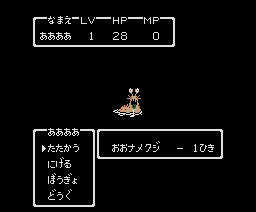 |
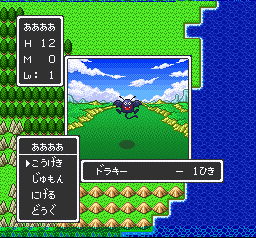 |
|
|
|
In the millenium we're living now (2001), this combat type isn't lost.. It's programmed, mainly, in hentai games (Ashgald) or in CRPG's creation tools (RPG Maker, in its versions 95 and 2000), with very detailed (and enormous) graphics and with beautiful backgrounds.
Variant 2:Combats in lateral/front/isometrical/??? view with characters
This type is an extension of the variant 1, adding some differences (mainly thanks to the biggest calculation power). In this type, our characters are shown during the combat, and there is a different background for each combat, depending on the land in which the combat started. Also, an (physical or magical) attack implies a graphic of the PC/NPC attacking (sometimes, like in the Final Fantasy saga , the enemies don't move, giving to change a bigger detail in graphics).
In this variant the scenario simulates a three-dimensional environment, although the form in which the battle is presented varies a lot:
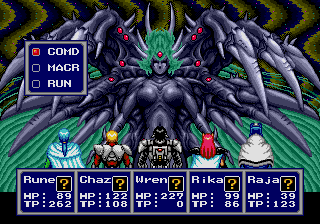 |
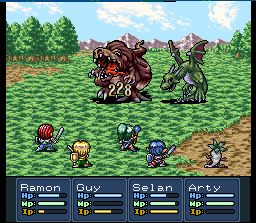 |
|
|
|
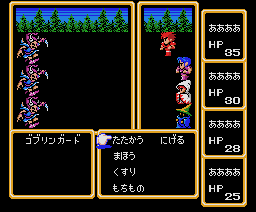 |
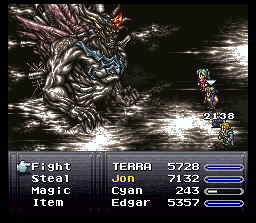 |
|
|
|
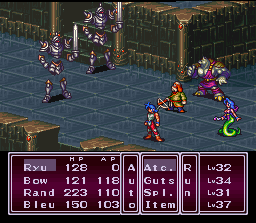 |
|
|
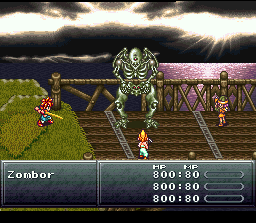 |
|
|
Variant 3: 3D Views
This is the most used variant now, for a simple reason: the power of the computers and the current consoles allow it. It has all the characteristics of the previous variants, but within an 3D environment (characters, enemies and scenarios are made with polygons). That means: camera rotations, any view, effects of lights and transparencies based on 3D technics,...wow..
In the first combats that used this variant (the
first games for consoles with CD, as the Playstation), the combats adopted
an 3D environment, but using 2D sprites. An example (and the best one for
us) it's Suikoden II, of Konami..
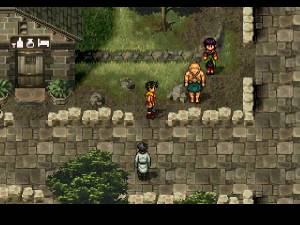 |
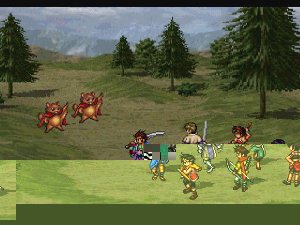 |
|
|
|
But the main exponent and initiator of the 3D enviroments
is Final Fantasy VII, of SquareSoft. Then, came (and will
come) many more (
Final Fantasy VIII and IX, Evolution,
Grandia
II, Phantasy Star Online,...)
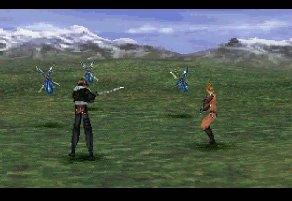 |
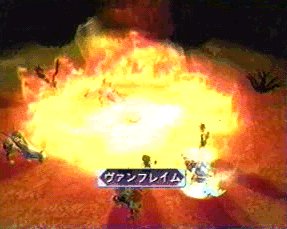 |
|
|
|
At the start of this tutorial, we spoke of Lord British...
...and about Ultima saga. This saga (starting from Ultima I) was the first one (we believe) that presented a strategical combat system. In it, the characters combatted against the bad guys moving in a land (12x7 tiles (we think)). The distance and the position counted, so the strategic factor was the predominant one.
There's only a few Japanese CRPG's that used this type of combat (The Shinning Force saga, Bahamut Lagoon, and other few ones).
Characteristics of this system
The main characteristics of this combat system are exposed next.
Like we say before, they are very few Japanese CRPG's
games that have adopted this combat system. One of them is the Shinning
Force saga. This game was developed for Megadrive, Game Gear and Saturn,
and it was between the strategy and the RPG, since their combats took place
in the same zones, at certain moments
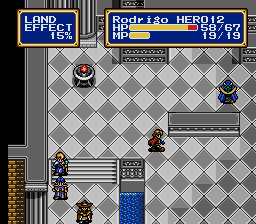 |
|
|
Another of the games developed with this combat system
was Bahamut Lagoon, of Squaresoft.
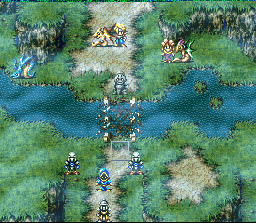 |
|
|
We can see that this type of combat has been very little used in Japanese CRPG's. Maybe the biggest problem that suffers this type of combat is its duration: a combat can be very long (more than 10 minutes), and that can end up tiring players. One of the few games that joins strategic combat with a good relationship combat/duration is Buck Rogers, of SSI (it is not Japanese). Another is Emerald Dragon, but we will speak of this game at the end.
Where this combat type has been most used?. In the strategy games (of course ^_^). As the best saga in this type of games we could mention the Fire Emblem saga (joins strategic combats with some RPGs elements). We can also mention Dragon Knight IV, of Elf.
Once upon a time there was a world named Hyrule...
...in that world lives a boy called Link, which always fights a guy named Ganon and tries to rescue a girl named Zelda.Well: Legend of Zelda has always been the banner of this combat type, but it was not the first one. Let's starts with the beginning...
Characteristics of this system
The main characteristics of this combat system are exposed next.
In a principle this combat system followed this rule: when the combatants were pushed, was when the attack took place. There wasn't any element of platforms (machine can't give more!). An example of games using this primitive scheme are the Hydlide saga, of T&E Soft.
 |
|
|
Hit means damage
...But things changed, programmers discovered that they could use more keys (^_-), and they began to put jump keys, attack keys, magic keys, etc, etc, etc. Also, with the step of the years (and the increase of the calculation power), the enemies adopted more AI and more attack methods, at the same time that the main character acquired more and more magic and more movements.
In 2D, the list of games that used this scheme were
enormous: Legend of Zelda Saga (for NES and SNES), Neutopia
Saga
(PCEngine), XAK Saga (MSX, Microcabin), Ys / Ancient
Ys Vanished Omen Saga (MSX-NES-SNES-PC, Falcom), Seiken Densetsu
/ Secret of Mana Saga (Squaresoft), Alundra (Playstation),...
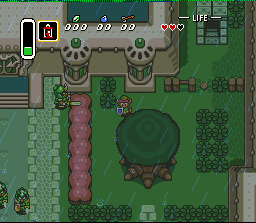 |
 |
|
|
|
Also there were intents of using this system in isometric
environments. The clearest examples in this field are LandStalker
(developed
for Megadrive) and LadyStalker (developed for SNES).
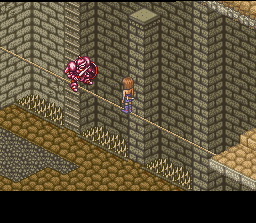 |
|
|
And now, this genre continues very alive in 3D environments: Legend of Zelda (N64), Alundra II,...
PLEASE GIVE ME GRAPHICS OF THESE GAMES ^_^
Under this title there're some games that deserve to be commented separated for their combat systems.
Emerald Dragon
This game was developed by Glodia, in a principle for MSX, then for Turbo-Duo (PCEngine with CD) and then for SNES. Their combat system is certainly singular: It is based on the strategic combat, but with some particularities:
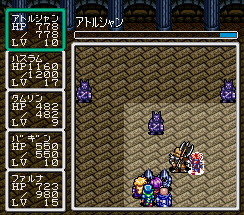 |
|
|
Tales of Phantasia
This game (developed by Wolfteam although distributed by Namco, and according to our opinion the best CRPG made for SNES) has the combat system more, more, more,... curious of all the games we've seen. Uses an "arcade" scheme, but...
 |
|
|
![]() AND
HOW CAN I PROGRAM THIS?. BASICS
AND
HOW CAN I PROGRAM THIS?. BASICS
Well, we've spoken of the most common combat types,
we've specified their characteristics,...but we say nothing of how implementing
them. So it's time to say some basics, cause this is a tutorial of HOW
can CRPG's be made, i think ^_-.
What we will say?. We'll summarize the differences
that exist in the implementations of each one of the combat schemes.
NOTE: We'll follow a small nomenclature,
Where are the enemies?
In the systems T and S, the enemies
appears according to a percentage (see maps lesson). Also, each section
of the map (or tile of the map) has the background of the combat and the
group of enemies against which will fight (The section 120 has 2 Imps and
1 Mosquito).
On the other hand, in the system A it is
not necessary to keep that information, since the enemies usually appear
always in the same place of the field map. This is only valid for most
of the non-old games (try to kill one enemy in Ys or in the
Seiken
Densetsu saga and go away enough: if you return the enemy will
appear in the same place). So, enemies are saved within the map or within
a special list.
Combat Area
In the system T, the combat area is a background
that depends on the area in which we were in the field map (except for
exceptions like Chrono Trigger).
In the system S, the combats are carried
out in field maps made especially for a combat, or in the same field map
where the fight were activated.
In the system A, the combats take place in
the same field map, so there's no need of loading anything.
Enemy behavior
In the systems T and S, the enemies
works in a turn-based world. That means that they decide what to do when
they receive their turn.
On the other hand, in the system A the enemies
act at the same time that the main characters, so it's necessary to use
a processes system (as the one that it is necessary to take care of walking
NPC's in the towns).
Enemies, AI
In the system T, the AI it's "only" choose
what PC attack, according to some parameters (HP of one PC and HP of the
group, characteristics of the group members, health of the group members,...).
On the other hand, in the system S it is
necessary to add more parameters, since we are fighting in a strategic
map (it is necessary to keep in mind the position, the distance, where
to be placed or where escape,...). Also, it is necessary to have path-searching
algorithms (A* ^_^).
In the system A it is also necessary to keep
in mind distances and position and other things, but not in such a detailed
way as in the combat system S (since an enemy is a process, little
time of AI-processing is necessary).
HP/Damage Balance
In the system S, each member of the combat
doesn't usually have more than 500 pv. Also, the nș of necessary impacts
to leave KO to anyone is usually between 2 and 4 (except for final or extremely
strong enemies).
On the other hand, in the systems A and T
the
main characters have between 100 and 9999 pv (the enemies has 1-100 times
more). Also, the damage that a main character does is quite bigger that
the one that an enemy does.
Platforms in Adventure RPG's
Games with A combat schemes has usually ingredients
of platform's games. It is for that reason for what it is necessary to
keep more information in the field map (area type (aquatic, sky, earth),
distance floor-area). Also, in this type of games the tile-by-tile movement
is a design failure (the characters should move pixel-to-pixel).
If you waited one (or more lessons) of combat-specific
programming, wait a litlle more. This lesson has been made with the objective
of showing you all the combats that exist in the CRPG's, so that you can
select your favourite for your game, or (as us we will make) to create
your own combat system.
We also had the objective that you see the evolution
of each combat system. And something very important: that in spite of graphical
evolution, the base is the same one. The combat of Final Fantasy I and
Final Fantasy VI (and FF VII, VIII and IX) it is identical in essence.The
only add-ons are graphical effects of polygons, lights and transparencies,
and some things more. But, in the deep, it is the same thing (Before: Flash.
Now: Ultra-Summon of three minutes).
And another thing: this classification and their nomenclatures are COMPLETELY subjective, based on our opinions and experiences. If you have something to criticize, to remove or to add to this lesson, remember that we wait for your mails!
All the images belong to their respective authors.
Their use is for educational purposes only. The creators of this tutorial
doesn't obtain any benefit.